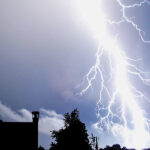• Obtain a variance from the U.S. Food & Drug Administration’s Center for Devices and Radiological Health. This document is the gateway into owning and operating lasers powerful enough for entertainment use. Laserists will find this extremely helpful, and those hiring laser vendors will learn why this document is crucial to having legal and safe laser effects on your production. A FDA CDRH variance is required in the U.S., but is also recognized as an excellent badge of credibility in the international community.
• Work with aviation authorities. This is usually a responsibility of the laserist, but the production may need to provide their laser vendor with show times, stage coordinates and direction of laser projection weeks in advance. Nearly all industrialized nations have procedures in place to request clearance and provide notifications for outdoor laser shows. These range from informal emails to detailed reports containing plots and calculations. If you’re planning on using lasers outdoors, but terminating them before reaching navigable airspace, many air authorities still want some form of notification. They use this information to release a Notice to Airmen. A NOTAM is a formal way to alert aircraft pilots of potential hazards along a flight route.
• Make show-specific filings. These can happen at country, regional, state, and local levels. Some are free, some have nominal costs paid to governments, but nearly every show will require at least one of these documents. Often these filings begin to overlap and may seem excessive at times, but provide an important safeguard by ensuring that laws and safety regulations are met in all jurisdictions. Once again, laserists will usually be responsible for this paperwork, with some information provided from the production.
• Know how to select the right laser vendor.
Reputable laserists will have a variance if working in the U.S., liability insurance, and create all necessary government filings. Professional laserists will be ILDA members. The most experienced of these will have undergone the additional steps to become ILDA accredited. (You can find a list at
laserist.org/Directory_IAPLC.htm.)
• Know about laser control options. Lighting designers rejoice! Most laser vendors can provide DMX or Art-Net control and custom effects for your production. All of which can be programmed for your lighting console. This merges laser control to run with the rest of your lighting rig. Alternatively, nearly all vendors can provide live operators with their own control equipment for a more hands off approach. Special projects can sometimes lead to developing new and unique control. Complex and tightly choreographed shows may use SMPTE or other forms of time code.
• Learn about laser logistics on your stage. Anyone sharing a venue with lasers will find this extremely helpful. Knowing how to work around laser equipment allows for quicker load in and a safe environment for all. Key tips include planning staff breaks for a 10-20 minute period so laserists can safely set zones without disrupting other aspects of load in.
• Understand audience scanning. This isn’t a new laser technique, but one that is skyrocketing in popularity as technological, procedural, and regulation advancements progress. Audience scanning allows laser light to safely pass over the eyes and bodies of the crowd. The effect is far more immersive than traditional laser effects, but more safety considerations must be made. Know what questions to ask your laserist, and ensure they’re qualified for this effect.
• Be aware of the latest visuals. Lasers have come a long way from single green beams shooting over the crowd. Effects have become increasingly complex, with some becoming the entire staple of visual performances. Smaller equipment, brighter lasers, full color equipment, and creative uses of optics have made lasers more versatile in placement and effects.
• Watch for more details to come. Keep in mind, this is just an overview. There are plenty of additional details to consider with each one of the eight topics outlined above. Look for a more in-depth discussions on laser safety regulations in future issues of PLSN, and also on the magazine’s affiliated websites, PLSN.com and ProLightingSpace.com. Also, be sure to visit laserist.org for the latest updates from the International Laser Display Association (ILDA).
Joe Schmitt, who has been working with Lightwave International (lasershows.net) since 2008, is a certified Laser Safety Officer.

